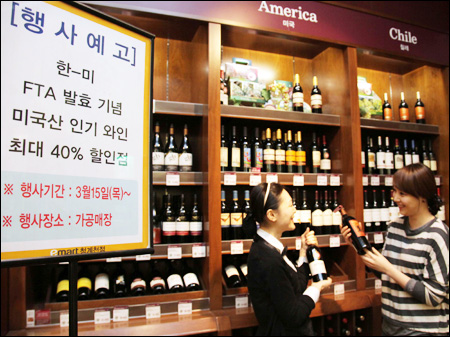Korean automakers are expected to benefit the most from the March 15 effectuation of the Korea-U.S. free trade agreement or KORUS FTA, analysts say.
Not so for the farming and fishing industries forced into a life-or-death struggle.
Under the agreement, tariffs for cars are to be eliminated in two stages.
By 2015, the 2.5 percent tariff the United States currently imposed on imported vehicles will be maintained, while the 8 percent tariff by Korea will be halved to 4. Starting in 2016, all remaining tariffs will be removed for all types of vehicles.
Hyundai Motor Group with Kia Motors under its wing expects trade friction from its mass exports will be eased, further emboldening the brand image of made-in-Korea vehicles.
Besides, the no-tariff status will make Korean cars more price competitive, meaning an increase in exports to the world’s biggest auto market.
Parts makers such as Hyundai-affiliated Mobis can also expect a big jump in their U.S. exports.
This would not be one-way street since U.S. carmakers will be able to enjoy the same benefits, although their easier access to the Korean market via the FTA would not necessarily lead to bigger sales, considering the low popularity of American cars here. German cars lead in the imported car market.
Textiles, once the beauty of the export-driven Korean economy but now left in the dust by cheap Chinese and Southeast Asian products, might be resurrected because the FTA will eliminate an average 13.1 percent or a maximum 32 percent in tariffs. Industry data shows the FTA will result in an annual 480 billion won for the next 15 years in terms of increased output.
Airline and shipping industries are also optimistic about a boost from a greater exchange of people and products.
Korean Air, the national largest carrier, has purchased bigger freighters such as B747-8Fs in anticipation of an increase in cargo, while Asiana Airlines has also started services to Atlanta, Miami and Portland, all to cope with the FTA’s effects.
For electronics and refineries, the bilateral trade pact with the United States won’t really help them out.
Tariffs have already been abolished on mobile phones, while televisions produced in Mexico are subject to no tariffs because of the North American Free Trade Agreement (NAFTA).
This is the same for the financial industry because it was yanked after since the 1997-1998 currency crisis.
Half of the small- and medium-sized enterprises (SMEs) feel a combo of anticipation and anxiety.
Those who make integrated circuits (ICs), polymers, auto parts, small ships and plastic products, the top five export items for SMEs, will likely receive a boost in their exports but medical equipment makers and pharmaceutical firms are expected to suffer.
Overall, the farming and fishing industries will suffer the greatest.
According to government data, output from them is projected to reduce by 703 billion won in the fifth year after the FTA takes effect; 1.28 trillion won in the 10th year and 1.28 trillion won in the 15th year. This averages out as an annual loss at 845 billion won.
The government plans to support the farming and fishing population with a combined 54 trillion won in tax benefits and financial support.
This expected loss gives the opposition power to push ahead with its call for the revocation of the KORUS FTA. If the ruling party falls in the April 11 polls for lawmakers, it could foreshadow another test to Korea’s bilateral trade pact with the world’s biggest economy. <Korea Times/Oh Young-jin>




